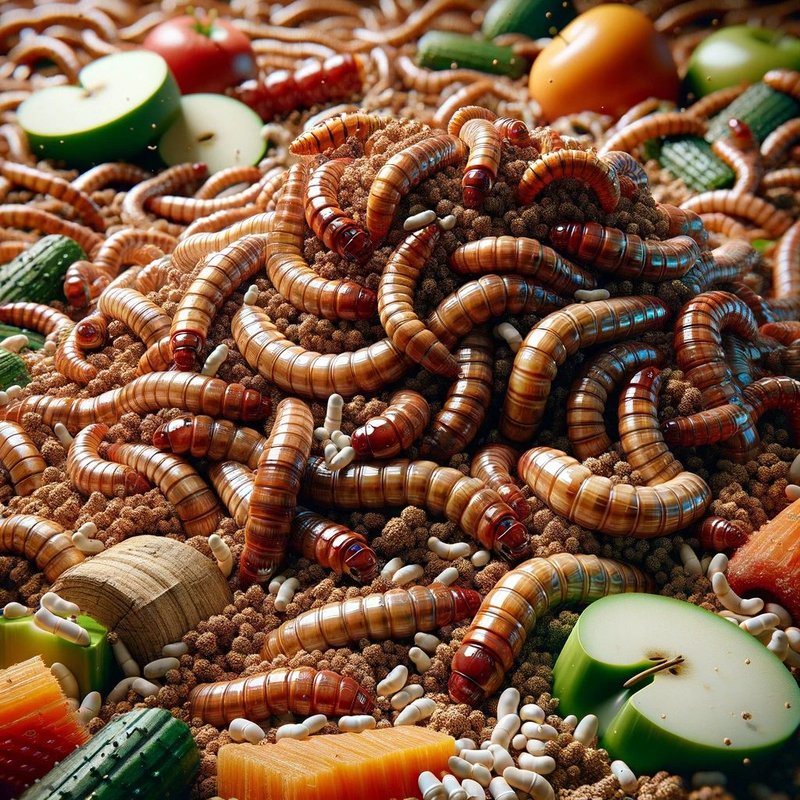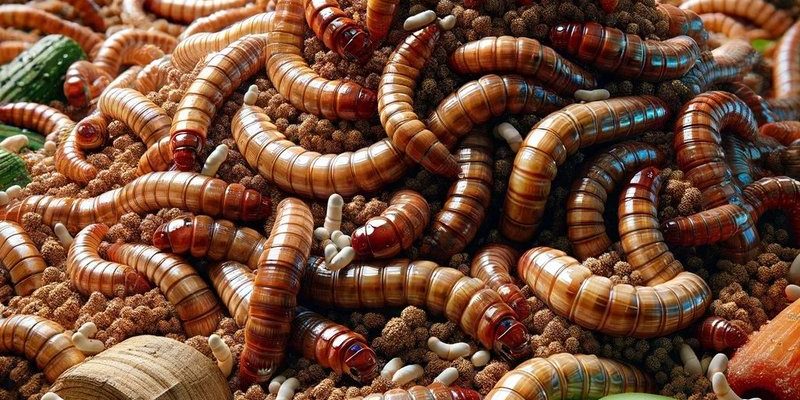
Imagine this: you’re in a bustling city, surrounded by concrete and noise. Now, picture a tiny mealworm lurking in the soil or decomposing organic matter. This little guy doesn’t just munch on food scraps; it also interacts with its environment, responding to pollutants and chemicals. By studying how mealworms react to certain conditions, scientists can gauge the health of ecosystems. It’s like having a yardstick for nature’s well-being. Curious? Let’s dive deeper into how mealworms can be used for environmental monitoring or bioindication.
What Are Mealworms?
Mealworms are the larvae of the Tenebrio molitor beetle. These little guys are often found in dark, warm places like your pantry or compost pile. They thrive on decaying plant matter and are rich in protein, making them a popular choice for animal feed and even human consumption in some cultures.
You might be wondering why mealworms are so special for environmental monitoring. Well, it’s because they have a remarkable ability to bioaccumulate toxins. When exposed to harmful substances in their environment, these larvae gather and store these chemicals in their bodies. This characteristic makes them excellent candidates for studying pollution levels. Essentially, if mealworms are thriving, it might indicate a healthier ecosystem; if they struggle, it could signal trouble.
How Do Mealworms Help in Bioindication?
You might think of bioindicators as the canaries in the coal mine for ecosystems. Just like those canaries once signaled danger to miners, mealworms can indicate the presence of harmful pollutants in the environment. Here’s how it works: when mealworms are exposed to contaminants, such as heavy metals or pesticides, their growth, survival, and behavior can change. Scientists monitor these changes to assess environmental health.
Researchers have found that mealworms can be used to detect a variety of pollutants, including heavy metals, pesticides, and even certain microplastics. Using mealworms in laboratory settings, scientists can expose them to controlled concentrations of these substances and observe how they react. By analyzing their mortality rates, growth rates, and behavior, researchers can gather crucial data about the toxicity of various materials.
The Benefits of Using Mealworms for Environmental Monitoring
There are several advantages to using mealworms for environmental monitoring. First, they are easy to maintain and require minimal resources. You don’t need fancy equipment or extensive training—just some basic care, and you’re good to go. This accessibility makes them ideal for schools, community projects, and even citizen scientists.
Another benefit is their quick life cycle. Mealworms develop from eggs to larvae to pupae and finally to adult beetles within just a few months. This rapid growth means scientists can gather data relatively quickly. For example, if a community wants to monitor pollution from a nearby factory, researchers can set up mealworm experiments and receive results in a matter of weeks.
Lastly, mealworms are sensitive to environmental changes. Their responses can reveal information about soil quality, water contamination, and even climate change impacts. By integrating mealworms into environmental monitoring programs, communities can gain valuable insights into their ecosystems.
Practical Applications of Mealworm Monitoring
So, how do we use mealworms in real-world situations? Let’s take a look at some practical applications. One common method is using mealworms in contaminated soil assessments. By placing mealworms in soil samples from areas suspected of pollution, researchers can observe how they grow and survive. If mealworms show significant mortality rates or stunted growth, it could indicate that the soil is contaminated with toxic substances.
Another application is in testing water quality. Scientists can place mealworms in water samples from different sources—like rivers, lakes, or near industrial sites. Monitoring their reactions can help gauge the toxicity of the water and identify potential pollutants that need to be addressed. Essentially, mealworms provide a low-cost, efficient way to monitor and evaluate the environmental risk.
You might also see mealworms used in educational programs. Schools can run simple experiments with mealworms to teach students about ecosystems, environmental science, and the importance of pollution awareness. This hands-on approach fosters curiosity and awareness of environmental issues from a young age.
Challenges and Limitations of Using Mealworms
While mealworms are handy little bioindicators, they’re not without their challenges. One major limitation is their sensitivity to specific pollutants. For instance, some heavy metals might be more toxic to mealworms than others, leading to skewed data. Researchers must be careful to consider these factors when interpreting results. It’s important to use mealworms alongside other monitoring methods for a more comprehensive understanding.
Additionally, mealworms are not suitable for every environment or pollutant. Certain habitats may have conditions that aren’t conducive to their survival, which could lead to misleading conclusions. Scientists often need to adapt their methods based on the local ecology and the specific pollutants they’re studying.
Lastly, while using mealworms in monitoring efforts is promising, it’s crucial to educate communities on the limitations. Many people may think relying solely on mealworms can provide complete clarity on environmental health, but they should be seen as part of a broader toolkit.
Future Directions for Mealworm Research
As researchers continue to explore the potential of mealworms, several exciting directions are emerging. One area of interest is genetic modification. Scientists are investigating ways to enhance the mealworms’ ability to detect specific toxins or pollutants. Imagine a future where genetically modified mealworms could glow in the presence of certain contaminants, providing instant visual indicators of pollution.
Another promising avenue involves integrating mealworm assessments with technology. For example, developing real-time monitoring systems using sensors alongside mealworm data could provide more accurate and comprehensive insights into environmental health. Combining traditional methods with technological advancements could revolutionize how we monitor ecosystems.
Moreover, there’s a growing interest in mealworms for sustainability. As we become more eco-conscious, using mealworms as bioconverters to break down organic waste or certain pollutants could pave the way for innovative waste management solutions. They could potentially help reduce landfill waste while providing valuable data on environmental conditions.
Using mealworms for environmental monitoring or bioindication is a brilliant example of how small creatures can make a significant impact. These little larvae help us understand our ecosystems better and raise awareness of the importance of keeping our environments clean and healthy. As research continues to evolve, mealworms could play an even greater role in environmental science, sustainability, and education.
So, the next time you see a mealworm, remember that this unassuming little creature might just be a tiny hero in the fight for a healthier planet. By embracing innovative solutions like mealworm bioindication, we can work together to create a cleaner, safer world for generations to come.

